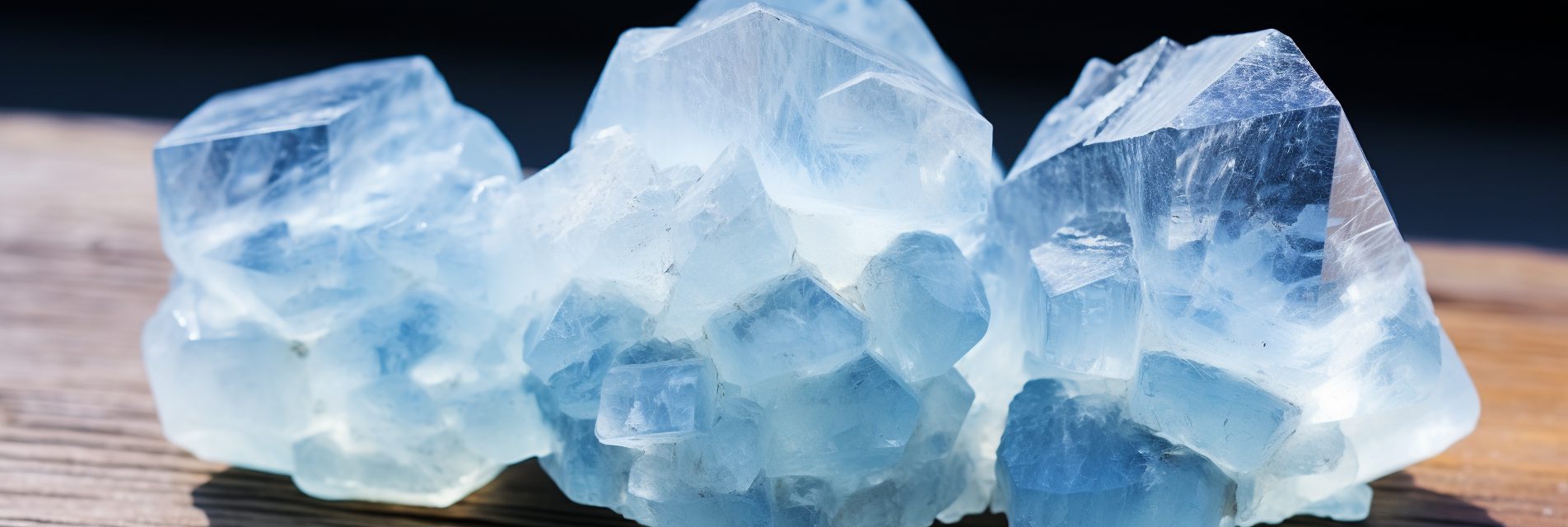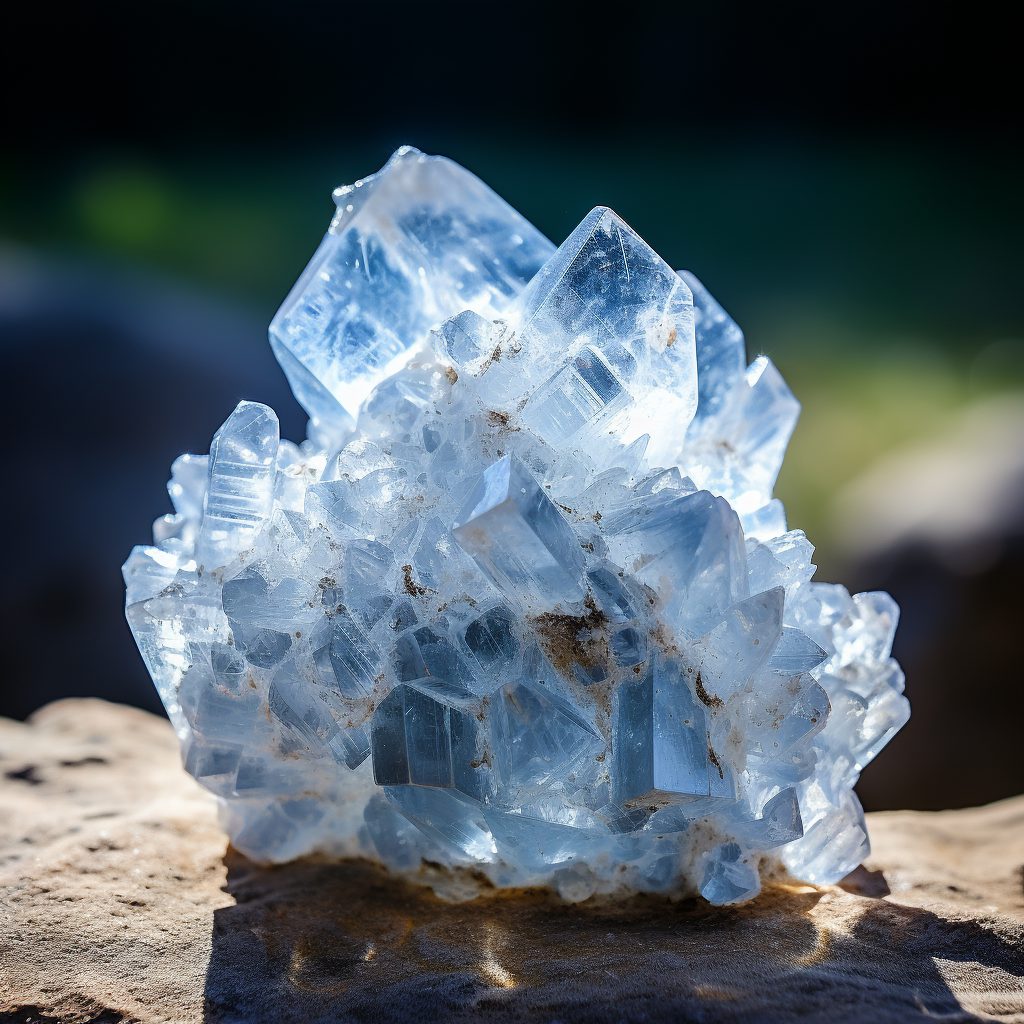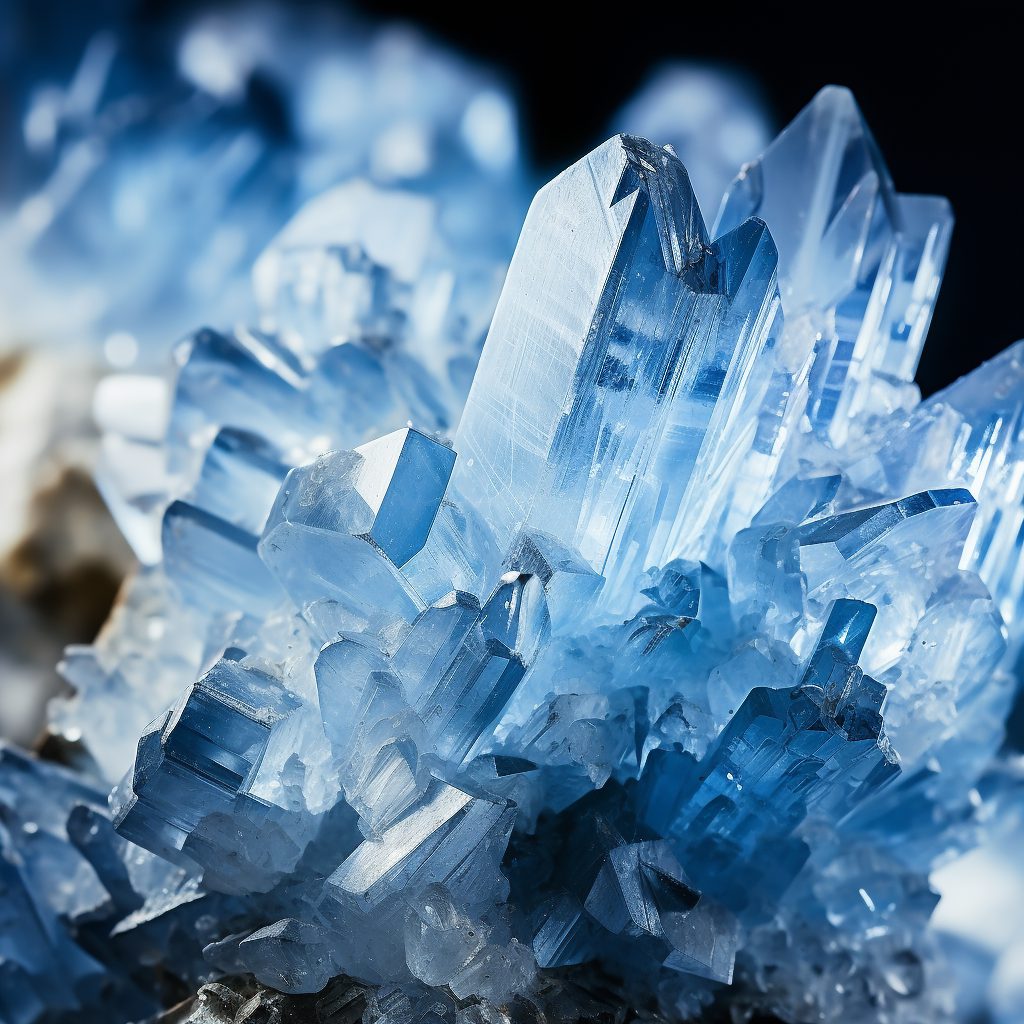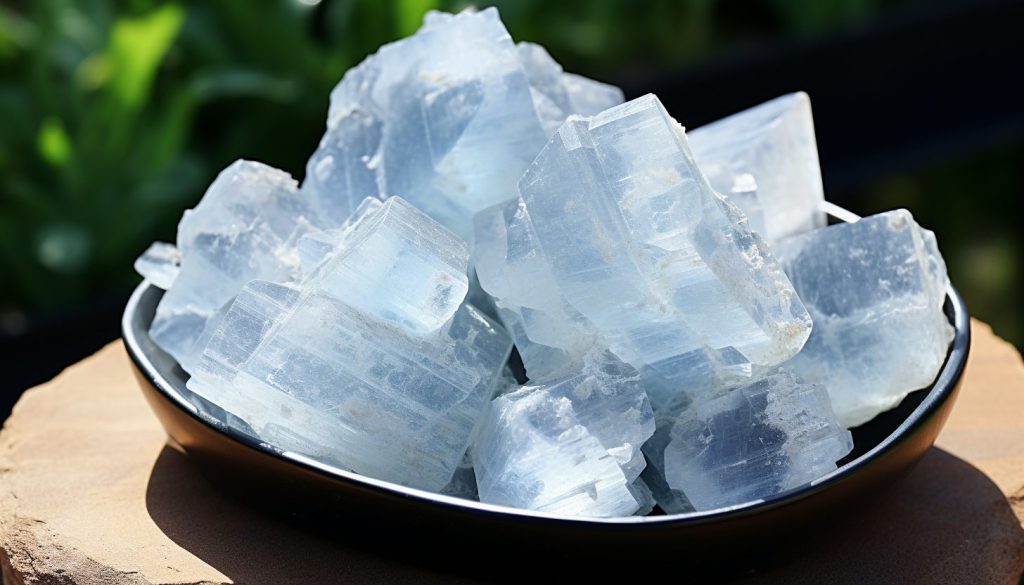What is Celestite?
Celestite, also known as celestine, is a mineral composed of strontium sulfate. This mineral is renowned for its stunning blue crystals which are thought to have a calming and uplifting effect on the spirit. It is a popular choice for mineral collectors and crystal healing practitioners.
Origin of the Name – The name “celestite” is derived from the Latin word “caelestis” which means “heavenly”. This name was given because of its sky-blue crystals that invoke a celestial sphere.
Celestite got its name from its celestial, sky-blue color reminiscent of the heavens. It is often called celestine, a common name that aligns with its scientific nomenclature.
Celestite can also be found in colors like white, colorless, yellow, and even with a slightly reddish or greenish hue, though the blue variant is the most sought after.
Celestite: History, Culture, Mythology, and Folklore
The intriguing journey of celestite throughout history is steeped in cultural nuances and folklore. Often dubbed as the stone of heaven, it has captured the fascination of many cultures. Let’s delve into its rich history and the various legends surrounding this heavenly stone.
In ancient times, it was believed that Celestite held divine powers. Its striking sky-blue hue led people to associate it with the celestial realms. Many ancient civilizations used this stone in ceremonies and rituals, as it was thought to facilitate communication with angelic entities.
Celestite also holds a special place in the world of folklore. It’s often considered as a symbol of peace and harmony, possessing the power to dispel negative energies and foster spiritual development. In various cultures, it was used as a meditation tool, helping individuals connect with their inner selves and the universe.
Fun Fact:
Historically, celestite was also utilized in the creation of firework and flares due to its strontium content. Strontium salts help in producing brilliant blue colors in fireworks, linking celestite’s earthly and heavenly associations even in modern times.
In modern times, the allure of celestite continues, with many enthusiasts seeking it out for its supposed healing properties and its undeniable beauty as a gemstone, finding its way into various pieces of art and jewelry.
Benefits of Celestite and Chakra Healing

Unveiling the benefits of celestite, one cannot overlook its reputed synergy with the chakras, particularly the throat chakra. Before diving deep into the specifics, let’s outline the various benefits associated with this magnificent stone.
Celestite is widely acclaimed for its calming and soothing properties. It facilitates mental clarity, fostering a serene and peaceful environment wherever it resides. People who engage with celestite often find a heightened sense of intuition and a deeper connection to their spiritual selves.
Chakra healing is an essential aspect of holistic health in various traditions, and celestite plays a significant role in this. Its resonance with the throat chakra, in particular, is profound. The throat chakra, also known as Vishuddha, is the fifth primary chakra, centrally located near the throat. This chakra is essentially the hub of communication, expression, and sound.
Chakra healing practitioners use celestite to balance and activate the throat chakra, fostering clear communication and expression of one’s truth. The gentle energies of celestite can assist in unblocking and harmonizing this chakra, promoting an effortless flow of energy and a deep sense of tranquility.
Furthermore, celestite’s celestial connections resonate well with the third eye chakra, aiding in spiritual enlightenment and the nurturing of psychic abilities. Its calming energies can help soothe mental unrest, allowing for a smoother meditation experience, facilitating a deeper connection with the higher self.
In essence, the integration of celestite into chakra healing practices can be a rejuvenating and spiritually uplifting experience, paving the way for a harmonized and balanced state of being.
Gemologist’s Guide to Celestite: Identifying Genuine Pieces
In the realm of gemology, the identification of genuine pieces is of paramount importance. When it comes to Celestite, a gemologist would focus on several defining characteristics to discern its authenticity. Here, we explore the integral features of genuine celestite and guide you on differentiating it from counterfeit pieces.
| Characteristics of Genuine Celestite | Guidelines to Differentiate |
|---|---|
| Color | Celestite is typically found in soft shades of blue, but can also occur in white, yellow, or colorless forms. A rich, consistent color can be a marker of its authenticity. |
| Transparency | Real celestite possesses a translucent to transparent nature. Any opaque specimens should be scrutinized carefully as they may be imitations. |
| Crystal Form | Celestite naturally forms in tabular, prismatic crystals. Knowledge of its crystal habit can aid in identifying genuine pieces. |
| Hardness | The Mohs hardness of celestite is 3 to 3.5, making it relatively soft. A simple scratch test can be a good indicator of its authenticity. |
| Luster | Celestite displays a vitreous to pearly luster, which contributes to its attractive appearance. Fake pieces might lack the distinctive luster of genuine celestite. |
To identify real celestite, a comprehensive approach involving careful examination of its physical properties coupled with expert knowledge on gemology is necessary. It is also beneficial to purchase celestite from reputable sellers who provide certificates of authenticity.
Remember, an informed buyer is an empowered buyer. Being well-versed with the characteristics of genuine celestite can safeguard you against acquiring counterfeit pieces and ensure that you add a truly special stone to your collection.
Spiritual Aspects of Celestite
When delving into the spiritual realm, celestite takes a prominent place as a stone embodying divine energies. Renowned for its serene blue hues that mimic celestial skies, it is a stone that brings tranquillity and harmony. One of the vital aspects of utilizing celestite for spiritual enhancement is knowing where to place it on your body. Let’s explore this further.
Celestite has a calming and uplifting energy, which can aid in attuning to higher vibrational frequencies. When used during meditation or healing sessions, it’s often placed in specific areas on the body to promote spiritual growth and emotional healing.
Here are a few strategic points where you can place celestite on your body:
- Third Eye Chakra: Positioned on the forehead, between the eyebrows, to enhance intuition and spiritual insight.
- Throat Chakra: Placed on the throat area to foster honest communication and expression of one’s truth.
- Heart Chakra: Rested over the heart to facilitate emotional healing and foster feelings of love and compassion.
- Hand: Holding celestite in your hand during meditation can help to elevate your conscious awareness and connect with angelic realms.
Furthermore, it can be worn as jewelry, such as a pendant hanging close to the heart, aiding in maintaining a constant spiritual connection. When positioning celestite on your body, ensure to do so with a clear intention, fostering a deeper connection with the stone’s celestial energies.
Celestite, also known as the ‘stone of heaven’, is believed to facilitate communication with angelic realms, offering a bridge to higher consciousness and spiritual enlightenment.
Celestite: Symbol of Serenity and Heavenly Connection

In the world of gemology and spiritual healing, celestite stands out as a beacon of peace and divine connection. This radiant stone is more than just a pretty face in your crystal collection; it is a powerful tool that symbolizes serenity and heavenly connection. Below, we delve deeper into the characteristics that make celestite a prized possession for spiritual enthusiasts and gem collectors alike.
A significant aspect of celestite is its purported ability to foster a deep sense of calm and tranquillity. Often used in meditation, the stone’s soothing energies can help clear the mind of noise and distractions, enabling an individual to connect more fully with their inner self and the universe.
“Celestite, a stone bearing the vibrancy of the sky and the depth of the oceans, serves as a gentle reminder of the heavenly connections that bind us all, helping individuals to navigate their spiritual journey with grace and wisdom.”
The gentle energies of celestite resonate well with the higher chakras, fostering a bridge between the earthly realm and the celestial domains. By embodying the essence of serenity and heavenly connection, celestite aids in nurturing an environment where spiritual growth and enlightenment can flourish.
Fun Fact: In many cultures, celestite is believed to be a potent tool for astral travel and dream work, helping individuals to explore higher planes of existence and receive messages from the angelic realms during their sleep or meditation sessions.
Whether incorporated into daily meditation practices, used as a centerpiece in a healing crystal grid, or simply admired for its stunning natural beauty, celestite remains a cherished stone that invites harmony, enlightenment, and a deeper connection to the spiritual realms into one’s life.
Geology of Celestite: Clusters and Formations
The exquisite stone of Celestite, also known as Celestine, finds its roots deep in the geological processes of our Earth. It is paramount to explore the geology of Celestite, understanding its formations, hues, and status in the realm of precious stones. Let’s delve into the depths of its geology to unearth the facts and figures that make this stone a celestial entity on Earth.
| Feature | Details |
|---|---|
| Formation | Celestite primarily forms from the sedimentary processes often found in marine environments. It occurs in the cavities of sedimentary rocks, often in association with minerals like gypsum and halite. |
| Hues and Predominant Locations | Celestite exhibits a range of hues from colorless to white, pale blue, and even yellow and green. The pale blue variant, known for its serene appearance, is predominantly found in Madagascar. Other significant sources include the USA, Peru, and Poland. |
| Status as a Precious Stone | No, Celestite is not officially classified as a precious stone. However, its unique properties and heavenly hues make it a sought-after mineral for collectors and spiritual practitioners. |
Understanding the geology of Celestite aids collectors and enthusiasts in appreciating its value and place in the natural world. Its presence in various hues and formations across different parts of the world makes it a noteworthy stone that brings a piece of the sky to your collection.
Celestite Art, Popular Pieces, & Celestite Jewelry
Known for its ethereal blue hue reminiscent of serene skies, Celestite has found a unique place in the world of art and jewelry. Let’s traverse through the various avenues where Celestite has marked its prominence and elegance.
Celestite Art
In the domain of art, Celestite graces various sculptures and decorative pieces. Artists and craftsmen often utilize this stone to create artworks that resonate with peace and tranquility. The celestial hue of Celestite brings a soothing and calming element to art pieces, making it a favorite choice for meditation spaces and spiritual sanctuaries.
Popular Pieces
Celestite has been a part of various exquisite art pieces around the world. Its presence in intricate carvings, elegant sculptures, and as centerpieces in collector’s arrays marks its popularity. Some popular pieces include Celestite geode formations, which are often displayed in natural history museums due to their striking beauty and complex structures.
Celestite Jewelry
In the realm of jewelry, Celestite steals the show with its serene blue hue that appears to encapsulate the sky within. Jewelers craft beautiful necklaces, earrings, and rings adorned with Celestite, bringing a touch of heavenly grace to the wearer. Its calming energy makes it a popular choice for individuals seeking jewelry with both aesthetic and spiritual properties.
Through its representation in art and jewelry, Celestite transcends its natural form to become a symbol of serenity and heavenly beauty, gracing the world with its ethereal presence.
Celestite and Astrology – The Connection with Birthstones
The world of astrology often intertwines with the energies of various gemstones and crystals. Let’s explore the fascinating connection between Celestite and astrology, focusing notably on its aspects as a birthstone.
The Celestial Connection
Named for its heavenly hue and celestial aura, Celestite has a strong connection with the cosmos. It is often considered as a stone that fosters spiritual connections, facilitating communication with the angelic realms and fostering a deeper connection with the universe. Astrologers and spiritualists alike recommend Celestite for those looking to deepen their spiritual awareness and strengthen their intuition.
Celestite as a Birthstone
While not traditionally recognized as a monthly birthstone, Celestite has found its niche as a spiritual birthstone for those born under the zodiac signs of Gemini and Libra. Its calming and balancing energies resonate well with the air elements of these signs, aiding in communication and bringing harmony to relationships.
For individuals born under these signs, Celestite jewelry or talismans can be a beautiful and meaningful gift. It not only accentuates their natural traits but also assists them in their spiritual journey, providing clarity and a sense of tranquility in their lives.
Celestite, with its sky-blue crystals, often resembles angelic energies and is sometimes referred to as a “teacher for the New Age” due to its ability to connect with the angelic realms and assist in spiritual development.
Celestite: Economy, Trade & A Guide for Collectors
The market for Celestite, much like other crystals and gemstones, is influenced by various factors including rarity, quality, and demand. In this section, we delve deep into the economic aspects surrounding Celestite, providing guidance for collectors and illustrating an outline of its current market prices.
The Economy Surrounding Celestite
The value of Celestite is determined by several factors such as its quality, size, and the place of origin. Generally, pieces with a deep, clear blue color and well-formed crystals fetch higher prices. The most prized specimens are usually from Madagascar, followed by other locations such as Peru and Mexico.
A Guide for Collectors
For collectors, it is essential to have a discerning eye to identify genuine pieces. Collectors should look for Celestite specimens with good crystal formations and rich, uniform color. Pieces free of inclusions and with a high level of transparency are generally considered more valuable. Furthermore, understanding the market dynamics and current trends can be a significant advantage when adding Celestite to a collection.
| Grade | Price per Gram |
|---|---|
| Premium Grade (deep blue, clear, larger size) | 8 – 15 USD |
| Medium Grade (lighter blue, some inclusions) | 3 – 7 USD |
| Commercial Grade (mixed colors, smaller size) | 1 – 3 USD |
Note: The prices mentioned are indicative and can vary based on the individual seller and the current market conditions.
Fun Fact: Despite its ethereal appearance, Celestite is a relatively abundant mineral, which means that it remains reasonably affordable, making it accessible for collectors at various levels.
Comparing Celestite with Other Stones
When it comes to mineralogy and gem collection, it’s often insightful to compare Celestite with other well-known stones, considering aspects like appearance, healing properties, and value. Below, we have drawn a comparison between Celestite and a few other popular stones to provide a more comprehensive perspective.
| Properties | Celestite | Angelite | Blue Calcite | Selenite |
|---|---|---|---|---|
| Color Varieties | Primarily blue, also found in white, yellow, and reddish-brown | Blue to lilac blue | Light blue to deep blue | White, clear |
| Hardness (Mohs scale) | 3-3.5 | 3.5 | 3 | 2 |
| Chakra Association | Third Eye and Crown Chakra | Throat Chakra | Third Eye and Throat Chakra | Crown Chakra |
| Healing Properties | Serenity, spiritual connection, dreams enhancement | Peace, spiritual awareness, verbal communication | Calming, emotional release, enhanced communication | Clarity, spiritual connection, protection |
| Economic Value | Moderate | Moderate to High | Low to Moderate | Low to Moderate |
This table serves as a guide to help enthusiasts and collectors understand the nuances between Celestite and other popular stones in the market, fostering an informed and enriched collecting experience.
Celestite: Care and Maintenance
Celestite, with its ethereal blue hue, is indeed a treasure to behold. To retain its heavenly charm, it necessitates a specific regimen of care and maintenance. Here, we elucidate the proper procedures to clean your Celestite and provide precautionary measures to prevent any inadvertent damage.
Steps on How to Clean:

- Step 1: Start by gathering all the needed supplies such as a soft-bristled brush, mild detergent, and a bowl of lukewarm water.
- Step 2: Place the celestite gently in the bowl of water, ensuring that it is fully immersed.
- Step 3: Allow the stone to soak for a few minutes to loosen up any dirt or debris.
- Step 4: Using a soft-bristled brush, gently scrub the stone focusing on areas with visible dirt.
- Step 5: Rinse the stone under a stream of lukewarm water to remove any soap residue.
- Step 6: Pat the stone dry with a soft, lint-free cloth. Allow it to air dry completely before storing or using.
What Not to Do:
- Avoid Abrasive Cleaners: Steer clear of cleaning agents with harsh chemicals as they can erode the surface of the stone.
- Stay Away from Ultrasonic Cleaners: Celestite is a delicate stone and the vibrations from ultrasonic cleaners can cause fractures.
- Avoid Direct Sunlight: Prolonged exposure to sunlight can cause the vibrant blue hue of Celestite to fade.
- Do Not Expose to High Temperatures: Celestite is sensitive to temperature changes which can cause it to crack.
- Avoid Rough Handling: Due to its soft nature, it can easily get scratched or damaged.
In conclusion, caring for your Celestite is an integral part of preserving its beauty and energy. Following these guidelines will ensure that your stone remains vibrant and undamaged for years to come.
Frequently Asked Questions
Is celestite powerful?
Yes, celestite is often hailed as a powerful crystal in various spiritual circles. It is believed to have the ability to foster spiritual development, facilitating communication with angelic realms and encouraging calmness and harmony.
What is the rarest spiritual crystal?
The rarest spiritual crystal is often considered to be the Pink Star Diamond, which is not only visually stunning but also carries a hefty price tag due to its rarity. Other contenders for this title include blue garnet, red diamonds, and Alexandrite.
Can I sleep with celestite?
Absolutely, many individuals prefer to sleep with celestite near their bed or under their pillow to promote peaceful dreams and a restful night’s sleep. It is believed to help in dispelling nightmares and fostering lucid dreaming.
Is it safe to wear celestite?
Yes, it is safe to wear celestite as jewelry. It is often fashioned into pendants, bracelets, and earrings. Wearing it is thought to bring peace and tranquility to the wearer, apart from aligning with its spiritual properties.
Does celestite help with anxiety?
Celestite is touted for its calming properties, which can be beneficial in alleviating symptoms of anxiety. Its soothing energy is said to bring tranquility and harmony to the mind, potentially easing feelings of stress and unrest.
What are some interesting facts about celestite?
Celestite, also known as celestine, is well-known for its beautiful blue hue and its ability to glow in the dark when exposed to ultraviolet light. It is often found in sedimentary rocks, and its largest deposits are found in Madagascar. The crystal is believed to foster spiritual growth and angelic connection.
Is celestine a Quartz?
No, celestine is not a variety of quartz. While quartz is composed of silicon dioxide, celestine is a strontium sulfate mineral. Its chemical composition and crystal structure are quite distinct from quartz.
Is celestite the same as selenite?
No, celestite and selenite are two different minerals. While celestite is a strontium sulfate mineral with a blue hue, selenite is a form of gypsum, which is a calcium sulfate mineral. They have different properties and appearances, with selenite often appearing translucent or pearly white.
Why is celestite blue?
The beautiful blue hue of celestite comes from the traces of impurities within the crystal lattice structure, which often includes elements like gold or palladium. These impurities absorb certain wavelengths of light, reflecting a blue hue that makes celestite visually striking.
What country is Celestite from?
Celestite can be found in several countries around the world, including Madagascar, which is home to some of the largest deposits of this mineral. Other notable sources include Peru, Mexico, and some parts of the United States, including Ohio.

